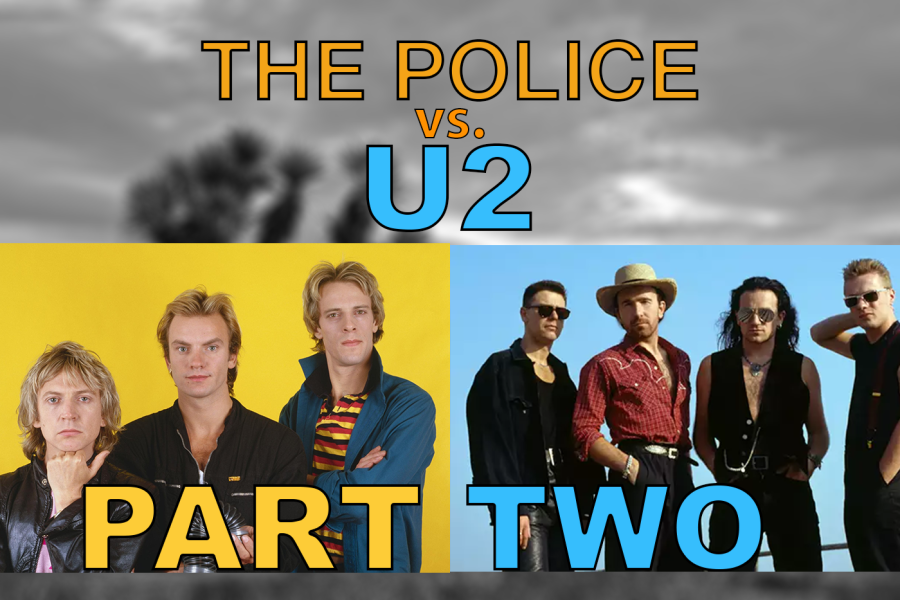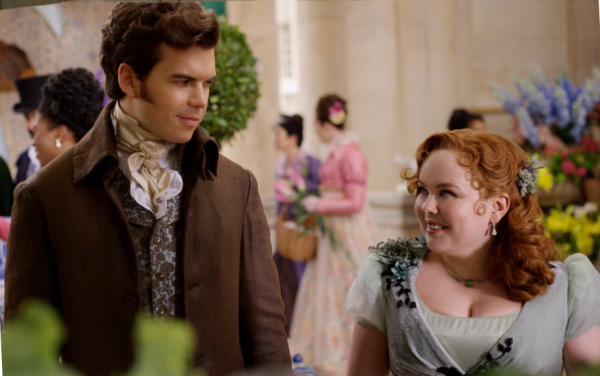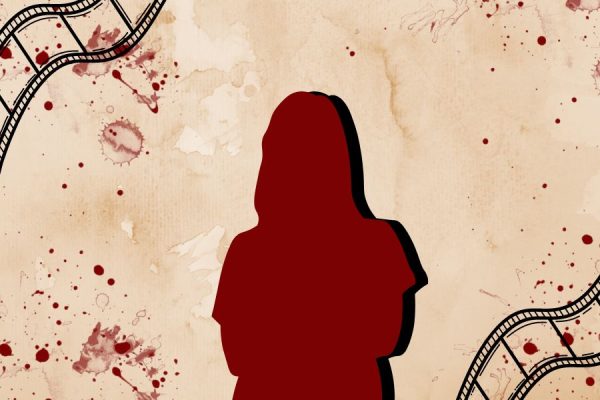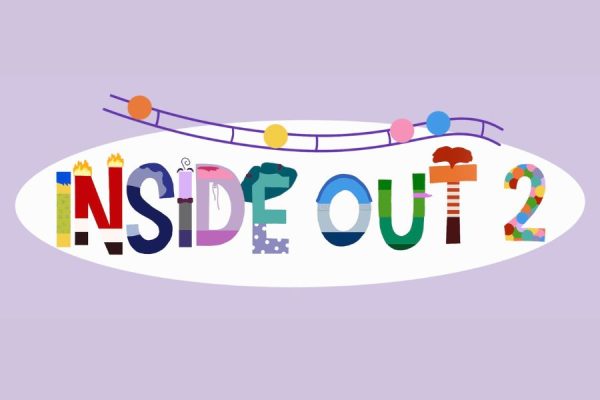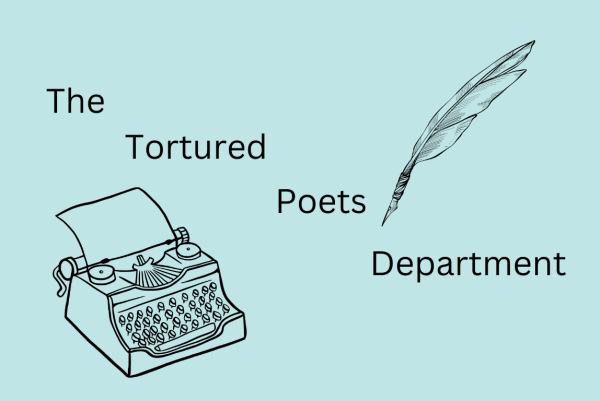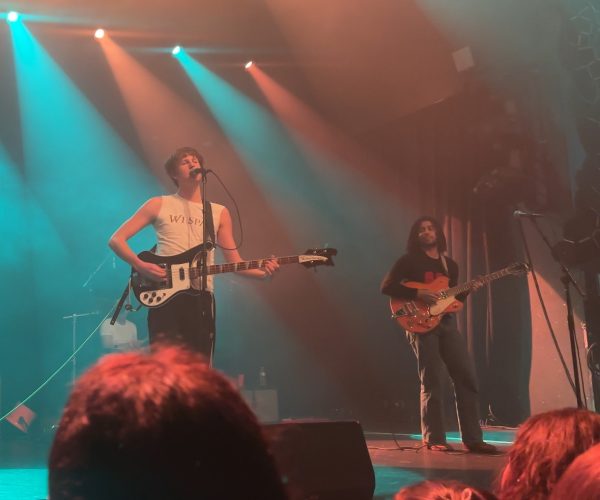The Police vs U2 – Battle of the 80s Blockbuster Bands (Part Two)
This piece is part two of a two-part series. Read the first installment here.
For their fifth release, both The Police and U2 created their most popular and artistically successful work ever- and both would take a toll on the band’s career.
The Police’s came out first, in June of 1983, and it took the world by storm, making The Police into the world’s biggest band and interrupting the chart reign of even the mighty Thriller. Its massive success can be attributed to the pristine production and the sheer poppiness of the album’s singles – indeed, it’s the band’s best overall record. Each song is beautifully cinematic and filled with vivid images, evoking other worlds and filmic scenes via shimmering guitars, rumbling bass, and moody keyboards, topped with Sting’s evocative vocals. We start strong with the energetic Synchronicity I, which opens with a percolating sequencer and continues with an onslaught of fast-paced rhythmic intensity. Both it and the second track, the slower Walking In Your Footsteps rely on a jumpy and circular marimba synthesizer riff that centers the song. Both take on philosophical themes in the lyrics and feature de-emphasized use of guitar and both are largely successful in creating a strong mood and atmosphere. O My God takes us back into familiar Police territory, with a bass-driven groove and a reggae lilt topped with typically atmospheric keyboard washes. The guitars resemble Walking On The Moon and the saxophones recall songs from Ghost in the Machine, overall making for one of the band’s most underrated songs. Oddly, Sting resigns the opening line of Every Little Thing She Does Is Magic during an instrumental break, something he’d repeat on his solo hit Seven Days. I guess he just really liked that line! Things go off the rails on the nearly unlistenable Mother – a screamed diatribe about possessive maternal figures yelped by Summers in a tortured squall. It’s truly awful and while the experimentation is admirable, it has no place on an album like this. Copeland contributes the next song, the quirky Miss Gradenko and it’s much better than Mother. Copeland’s typically off-kilter style of melody and instrumentation takes over and it’s a welcome addition to the record’s sound. The quick guitar arpeggios are pleasant to listen to. The tones on many of the songs are very jazzy and point toward the future of the member’s solo careers. So far, so good, but the album truly picks up on the amazing Synchronicity II, which oddly has nothing to do with the first installment. It’s an intense rocker backed with ominous synths and chilling and cryptic lyrics from Sting. Summer gets a chance to rock out, and Sting squalls his heart out with truly fascinating lyrics. This was the first Police song I truly loved and it still gives me chills to this day. It might be my favorite Summers guitar track, as he lets go of a ripping wall of ghostly feedback during the song’s bridge as well as a sturdy and metallic riff. It was popular on rock radio but its success was nothing compared to the absolute dominance of the next song, the band’s most popular song and one of the most popular songs ever recorded – Every Breath You Take. It’s so utterly unlike the band’s other material that I frequently forget they recorded it. The drums are simple-stupid, the guitar is a simple repeating arpeggio and the bass is just a simple 4/4 pattern, and the lyrics read upon first listen as simple love song treacle. And yet. It’s the most-played song in radio history. Dig beyond its suffocating popularity, though, and you’re left with a powerful and masterful pop song. The guitar arpeggio is deceptively sinister and difficult, the washes of synths and pianos that adorn the song give it a foggy and cinematic feel, and of course, the lyrics are horrifying on further listen. Sting’s romantic croon masks the fact they paint the portrait of a truly deranged individual who is stalking his lover. Appreciate its darkness and you’ll be rewarded with one of the band’s most interesting songs, and one of their best. Forget the overplay and wedding ceremonies. It’s a genuine moody masterpiece. The even moodier and downbeat King of Pain follows, and it’s just as good. The harmonic guitar and marimba synths match Sting’s depressed lyrics like a glove and the building of instruments and elements as the run time continues makes for an engaging and gradual listening experience. Similar in tone but not quite as successful is Wrapped Around Your Finger. It’s still a great song, but the best part comes too late – the transcendent ending as the tempo picks up and other band elements begin playing is amazing, but the build-up is too long and the rhymes are somewhat lazy (college, knowledge) but nevertheless it’s still a haunting and brilliant tune. The music video was one of several produced for this album cycle and as with their other videos, the cinematic and visually striking mood propelled the songs from radio hits into MTV hits. But Sting’s over-acting in the video was controversial within the band – as was his every move, as it would turn out. Summers and Copeland had grown to hate the pretty boy singer and how much he controlled the band’s every move. His antics and control over the songs and lyrical themes made him a pariah and the feeling seemed to be mutual. Pretty much everyone within the band’s inner circle knew that Synchronicity would be their last album, but at least they went out with their best work, a stunning batch of cinematic and fascinating songs
The trio’s last concert was on June 15, at Giants Stadium in New Jersey. They closed the set with Invisible Sun, and who else but Bono came on stage to join them. After this, the band passed their instruments to the members of U2 and performed a grand finale side by side. You couldn’t ask for a better metaphor – The Police passing the torch to U2, crowning them the next biggest band in the world. U2 quickly lived up to this promise by recording and releasing The Joshua Tree – their magnum opus, both critically, artistically, and commercially. It’s without a doubt their best album, and one of the best albums ever made. It fulfilled their early promise, turning them into international superstars and the most popular and beloved band of the 80s – while The Police came close, even they couldn’t hope to surpass the success that U2 achieved with their 1987 masterpiece. But the road to greatness was not easy – the band encountered obstacles and problems whilst recording, but it was worth it. The Joshua Tree is a seamless blend of the band’s chiming post-punk, electronic, and ambient textures, and American roots music. Every song is fantastic and emotional, filled with passion and beauty alongside intensity and power.
Brian Eno and Daniel Lanois returned to produce after the success of The Unforgettable Fire, and their influence is just as noticeable within the vast soundscapes and sparkling synths. But new to the mix was the group’s newfound interest in American blues and folk music. Bono and The Edge were listening to and hanging out with artists like Bob Dylan, The Rolling Stones, and BB King. Their rootsy, down-home style was far from U2’s electrified arena rock and the band was eager to infuse some honesty, some earthiness, and regionality into their European sound. This newfound kinship with American music extended to a few of the lyrics, which started focusing on increasingly American themes too. It should be noted that this influence is sometimes overstated – around half of the songs have an easily detectable American influence but a lot of them could have easily fit on The Unforgettable Fire before the Americana seeped in.
These influences are particularly undetectable on the opening track, and the best song on the album, Where The Streets Have No Name, an epic and sprawling painting of sound and color. We begin with a nearly undetectable swath of warm synth, slowly rising in volume. Played by Eno, it’s strongly reminiscent of his ambient music works, wordless and nearly without melody, reminiscent of sunrises or a warm bath. Slowly but surely, however, we hear a classic U2 signature fading in. The Edge’s ringing opening arpeggio is one of the most iconic figures in rock music and to me evokes headlights crashing through the fog of the synths. Soon, a driving bassline and thundering drums enter, and measly two minutes have passed before Bono begins singing, his voice as breathless and passionate as it would ever be. The lyrics are vague and emotional – while the rest of the album is relatively specific, this song has lyrics that serve mostly as emotional signifiers. This, coupled with the stratospheric instrumental and Bono’s powerful vocals, make this a genuine anthem and my pick for U2’s best song. But making such an effective and incredible work of art wasn’t easy – the changing time signatures and lengthy runtime made it difficult to perfect in the studio, and Eno even planned to erase the song completely before cooler heads prevailed. Aided by a great video that portrayed U2 fans as almost tribal, the song was a great success.
Following this is one of the more Americana-indebted songs on the record, the more low-key but still soaring I Still Haven’t Found What I’m Looking For. Utilizing gospel-esque choirs and a rolling rhythm, the lyrics concern a spiritual need to connect, a sentiment most people can relate to. Indeed, I’ve found this song to be one of the most popular U2 songs with younger people, as its message still resonates to this day. While I don’t love this song as much as I do some of the other tunes on the album, it’s undeniably great and to me sounds timeless, as though it could have come from centuries ago as some kind of folk song. The song hit Number One, but it wasn’t the only song on the album to do so.
The first single was the third song on the album – the plaintive ballad With Or Without You, arguably the band’s most famous song. This song played everywhere when I was a kid and for a long time, I got sick of it. But at a distance, since some time has passed, the song is excellent and emotionally affecting. The song is the epitome of a slow burn – it takes forever to reach its peak but the buildup is consistently interesting and leads up to the soaring chorus in an entertaining and engrossing fashion. The opening keyboard arpeggio, supplanted by a flat drum machine, is slowly joined by a simple bassline, meandering guitars, and Bono’s brooding vocals. His delivery is sultry this time, smooth and sophisticated with an edge of pain and desire that gives the song a smoldering edge. He’s singing in his lower register and it’s not until later that we hear his voice at the peak of his powers. His simmering performance is exemplified well in the hit music video which features many shots of Bono looking cool and mysterious while wearing a guitar that he never actually plays. Eventually the drum machine is replaced by real drumming, and a classic Edge guitar figure enters the mix as Bono builds in intensity. The lyric isn’t spiritual or political, instead being a relatively straight-forward pained with desire narrative, albeit one replete with tortured metaphors and overheated imagery. Eventually, Bono gives up on metaphors and similes and instead just wordlessly whoops in a breathtaking emotional climax, creating one of the album’s best songs and their most inescapable hit.
The tone changes very drastically with the following track, Bullet the Blue Sky, which contrasts sharply with With Or Without You – whilst that song was a simmering ballad, this is a high-energy rocker with dive-bombing guitar and cavernous drums, replete with a politically charged lyric. This is the most punk song on the record, and it provides a much-needed “edge” to the album, possessing some of the most hard-hitting instrumentals the band would cook up. Bono even gets to do some spoken-word acting halfway through. It’s a little cheesy but I appreciate his effort. From the fierceness of this track, we return to calm with a drowsy slide guitar that opens Running to Stand Still, the rootsiest track on the album. The lyrics concern drugs and the melody is powerful and brooding. You don’t hear this one nearly as much as the first four but it’s just as good. When looking at the tracklist before listening, I recognized only the first four songs and expected the quality to drop off swiftly after Bullet, but on first listen I was struck by the emotional power of the fourth track, which beautifully paints a picture of drug addiction with simple instrumentation and classic blues elements like harmonica and slide guitar.
Red Hill Mining Town opens side two with a plodding rock beat topped with a signature Edge arpeggio. The group had high hopes for this song that were unfortunately never realized, filming but never releasing a high-budget, glossy music video and aborting plans to release it as a single. Apparently, the band wasn’t happy with the final song, never playing it live until 2017. An attempt to include a brass band was found off-key and the performances were not to the group’s liking, and to top it off they didn’t like the music video either (it is amusingly awkward but looks great, capturing Bono in all his stern homoerotic glory amidst a mine backdrop). The final song is good, but it never quite clicks in the way you want it to. The beat moves a bit too slow and the chord progression feels wrong, but the lyrics (about mining strikes) work, and Bono is great as always. The more up-tempo In God’s Country follows, and while the band didn’t think highly of it either, I actually quite this almost jaunty song. The shimmery electric guitars mix well with a spirited acoustic guitar and the short running time and Bono’s comparatively low-key vocal contrasts well with the longer and more overwrought songs on the album. A Trip Through Your Wires follows, a bluesy romp complete with a honking harmonica. It’s another one of the rootsier and Americana-influenced songs on the album and it’s pretty decent. The attempt at a loud raucous jam rings false but it’s a good change from the record’s prevailing stock-serious mood.
The album’s most underrated track, the spiritual One Tree Hill, follows. We open on some fast-paced and intricate percussion and some sliding guitars and steady bass, joined by a full drum pattern quickly, after which Bono begins his vocal, detailing a spiritual journey that celebrates the Moari culture. Roadie Greg Carroll had taken Bono to a volcanic peak called One Tree Hill during the Unforgettable Fire tour and Bono was struck by the religious significance of such a place. Carroll’s death before the song’s recording added an emotional resonance to it, and Bono refrained from performing it live due to the sentimentality and memories it evoked. By the end, he is shouting and exalting, pure emotion overtaking his voice and soul. The Edge even gets to rip out a truly nasty guitar solo, before the song abruptly ends. After some silence, we pick back up for a plaintive and passionate vocal coda that stands as one of the album’s most transcendent moments.
The decision to sequence the record’s three most popular songs at the beginning of the album was not entirely accidental. The album’s single mixer’s wife (talk about a job title) was asked to order the songs in order of her favorite to her least favorite, and this sequence was chosen as the final tracklist (although the band staked Where The Streets Have No Name and Mothers of the Disappeared as first and last tracks). So it should stand to reason that Exit, the penultimate tune, is the worst on the record. And that isn’t true at all. It’s easily the most sinister song on the album, lead by a rumbling bass figure and a reverby Bono vocal. The cryptic lyrics seem to detail a deranged mind or some kind of murder. The influence of artists like Joy Division and Siouxsie and the Banshees that the band once carried resurfaces in this song, with the spooky and foreboding tone providing a necessary injection of darkness into the shimmering sunsets that dominate the rest of the album. The pulsing synth-bass is almost horror movie-like, scattered over with slinky lead guitar strokes. Another downtempo song follows, ending the album on dual somber notes. We open a similarly foreboding drumbeat that is so processed it sounds like a synthesizer, arpeggiated and metallic. They are soon joined by a sweet classical guitar melody that brings an almost meditative tone that eases the tension of the robotic beat. Slowly we lose the anxiety of the previous song and opening, and Bono’s calm, smooth delivery lulls us into security. The classical guitar figure is soft and beautiful, and Bono’s crooning is truly moving. As the song continues, the synthesizers, choir, and guitar increase in volume, creating a beautiful bed of heavenly sound that is one of the album’s most transcendent and moving, all before that robotic drumbeat re-enters the mix to fade the album out, forever. Thus U2’s finest work, and one of the best albums of all time, ends. Simply put, The Joshua Tree is a masterpiece, each song a finely crafted miniature world filled with light, dark, and passion that truly moves the soul. You don’t have to be a U2 fan to enjoy it – before listening, I certainly wasn’t. But listening to the album at full blast while driving down wide Texas roads at sunset was one of the best music moments I’ve ever experienced and from that point on I’ve loved the album to death. While some songs are certainly better than others, the ones that work are magical and represent some of the most moving and powerful music ever recorded, all the way from the opening ocean of synth sound to the sinister drum loop that closes the record. You don’t have to be religious (I’m not) or understand the political events that Bono details in his lyrics (I don’t) to emotionally connect with the song lyrics either. Knowing that Bullet The Blue Sky is about El Salvador adds a layer of meaning but even if you don’t know that it’s still an amazing rock song.
U2’s immediate follow-up was 1989’s Rattle and Hum, a bloated double album and accompanying concert film. While it sold well, the record leaned far more heavily into roots music, and it lacked the experimentation or honesty of The Joshua Tree. U2 may have thought that the bluesy elements of their album were what made it successful, and while that was partially why, what really made the public love the record was its emotion and beauty, the universal themes, the stunning production by Eno and Lanois (both of whom didn’t return for Rattle and Hum). Plus, the documentary painted the band as clueless and out of their depth, and far too serious for their own good. U2 was clearly missing the passion and energy that made them special. What they needed was a reinvention, and with the onset of the 90s, they completely revamped their sound to great success. Of course, we won’t get into that today. What you need to know is that while U2 and The Police (remember them?) had adjacent careers during the 80s, they diverged completely after this. U2 remained hugely successful, but their endless stream of albums and Bono’s public smugness started to grate in fans, while The Police only reunited once, letting their fanbase grow and leaving their legacy intact. Today, it’s much cooler and socially acceptable to admit to being a Police fan than being a U2 fan, because they haven’t tarnished their legacy with mediocre albums and dumb stunts (remember when U2 automatically loaded that album onto people’s iPhones?). Since their breakup, The Police toured only once, for an immensely successful reunion tour. No additional musicians were included, just the basic trio, and the no-frills stage show showcased their ace musicianship perfectly.
These two bands are two of the best rock bands of all time. But both have flaws, and both mirror each other well. Their stories are analogous and their music is vastly different but stemming from the same well of influences. And of course, Bono and Sting remain as simultaneously hated and beloved as frontmen can be.
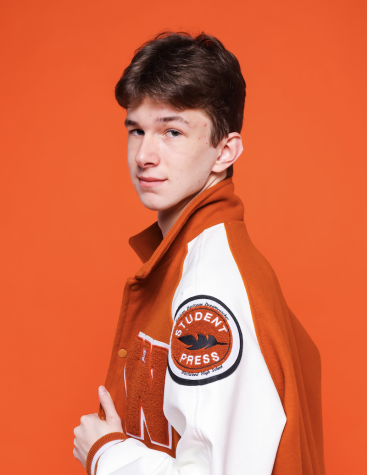
Class of 2023
I am currently Westwood Horizon's video editor, and also one of the hosts of Friendcast, our website's podcast video series. In addition...

